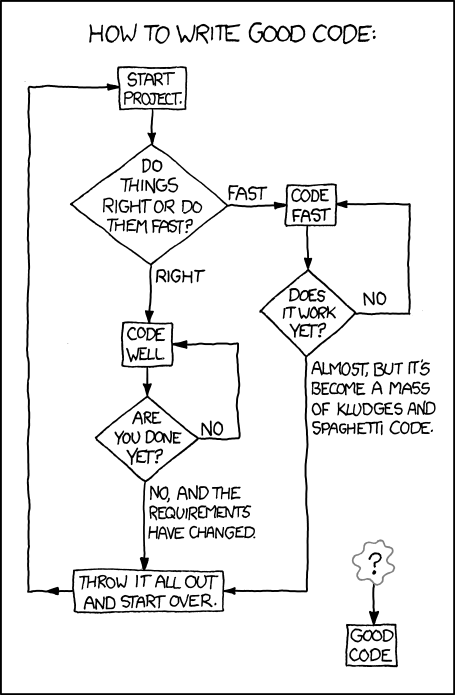I love xkcd. It’s a MWF dose of nerd crack. So for Christmas my wife gave me a copy of Thing Explainer, by xkcd’s author. This creative book simplifies complex ideas using only the thousand most common English words. So instead of “washer/dryer” you get “boxes that make clothes smell better”. “Thousand” becomes “ten hundred”. The “Saturn V rocket” becomes the “Up-Goer Five”. “NASA” is “US Space Team”. Entertainment and enlightenment in one place.
It inspired me to try my hand at it. I took the text of a previous blog post and winnowed it down using the simplewriter tool. The process taught me several things:
- Making something simpler improves your understanding of that thing. If you can’t take a ten-letter word and break it into a few five letter words – do you truly understand it?
- Simplifying also means more than just making a bunch of details smaller. I took the words that I had written without the “thousand words” in mind and changed them in place. The post would have come out much cleaner if I hadn’t kept myself to the same layout and idea structure. In other words, I made some of the words simpler but not the idea.
Simplifying means challenging your assumptions and then changing your model accordingly. Making something simple is harder than making it complex. That’s why so much software winds up kludgy. Case in point: my exercise in the thousand words trick made the post less simple, because I focused on a bunch of small things first without cleaning up the idea itself. If your users complain they can’t use your software and your thoughts go to the background color of your input boxes – you’ve gone down the wrong path.
Why am I going on and on about simplification? Because at Mindset, that’s what we strive for. Top to bottom. Ideas to details. All our foci – mobile, cloud, analytics – aim squarely at simple.
Without further ado, I present “Gopher Works” pseudo-simplified (with handy glossary below):
Dirt Throwing Animal Works
- A computer information plan that joins information tables with Pretty Screen Maker. Take any information table view and put it into the Pretty Screen Maker way of meeting your computer people – and do it either in your computer house or in someone else’s computer house with In-Memory Computer Information Plan Machine Cloud Computer System Plan Service.
- We bring Information Finder power to Business Computer Information Plan Maker. In a lot of ways, actually.
- Cloud Information Sheet Helper for information puts information fixing in the cloud for simple, easy to use doing things.
- Information Finder Controls for Pretty Screen Maker lets you take the doing things suite of Information Finder for Work and join it your big business money plan in Pretty Screen Maker.
- On-Clothing Problem Telling System. Put on an arm computer and get some heavy things work done.
- Cloud Information Sheet Helper for Information Helping gets your Business Computer Information Plan Maker Information House information into your cloud information sheet, as fast as you can go.
- We built a computer information plan that joins Word Shooter to Pretty Screen Maker through In-Memory Computer Information Plan Machine Cloud Computer System Plan Service and ran a game to win money on it. In a matter of days.
- Lots of other things I’d love to tell you about, but are quietly held with the people who give us money. Let’s just say they’re really great problem fixers that would blow your mind.
Just don’t call us Dirt Throwing Animal Works, because I’m the only one in the office who thought that was a cool name.
